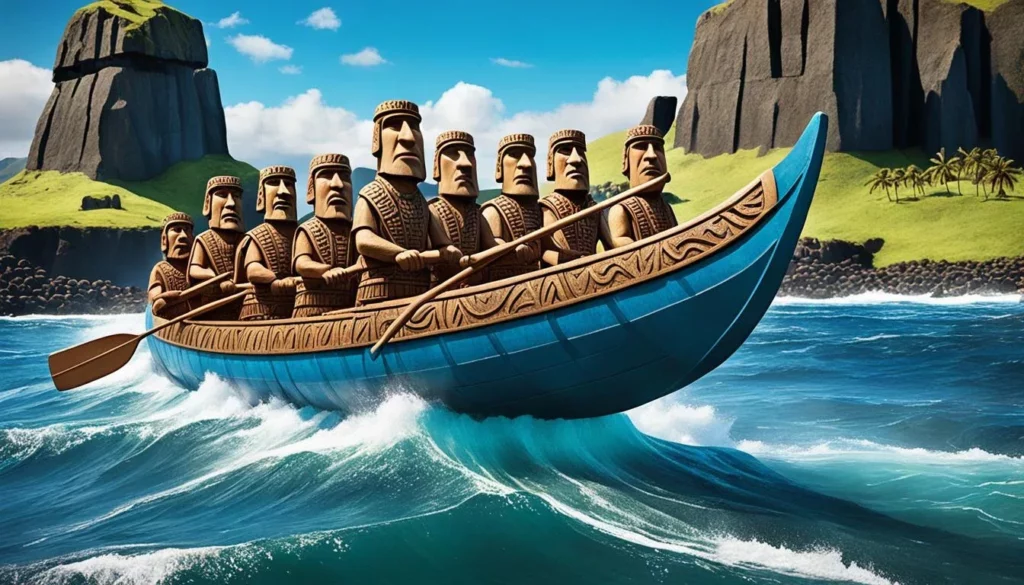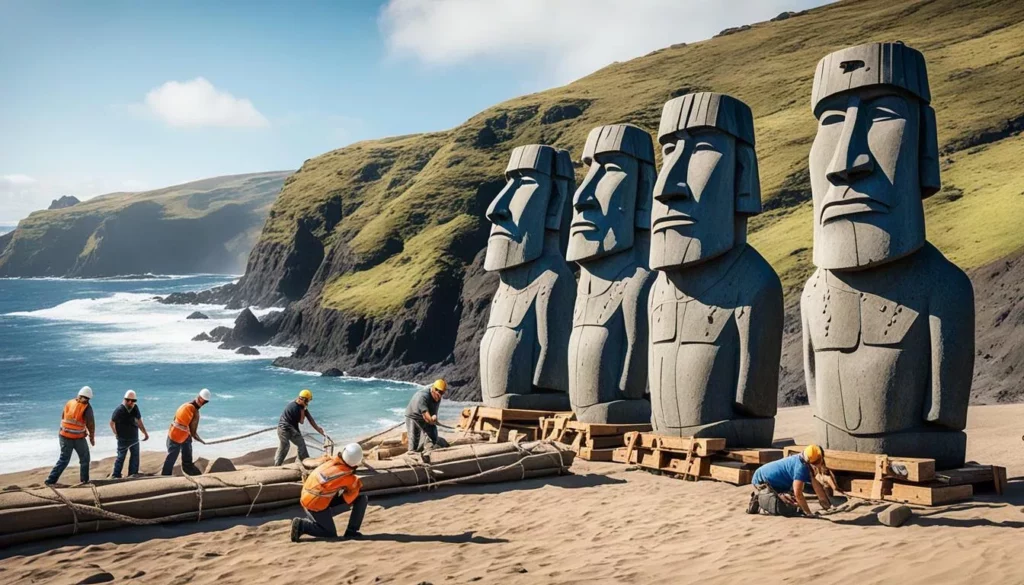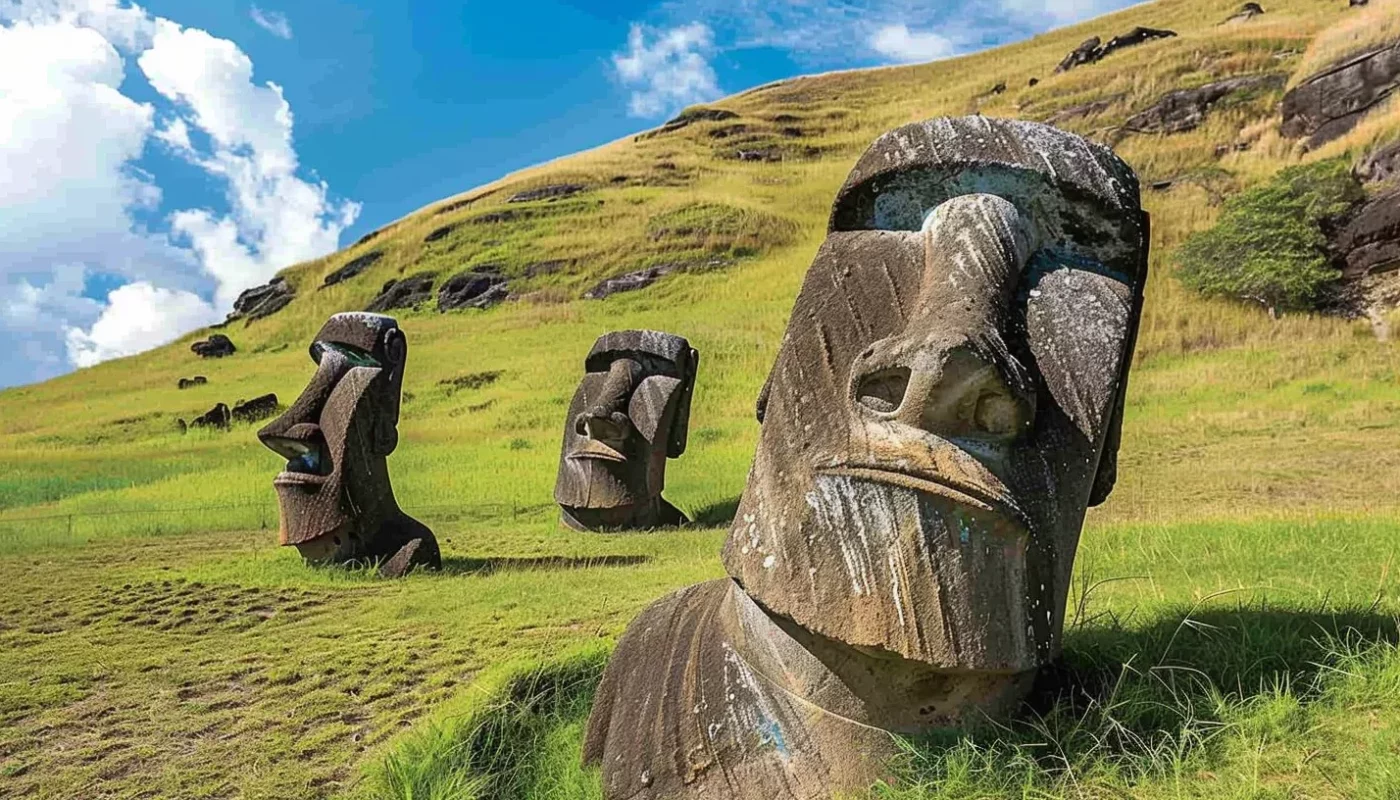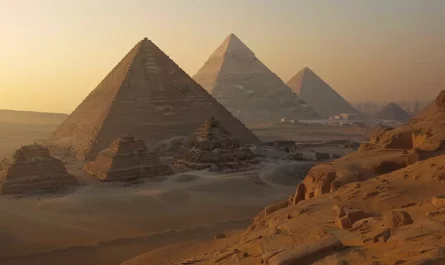Did you know the tallest Moai statue on Easter Island is named “El Gigante” and is 69 feet tall? Easter Island, one of the most remote places, is famous for its statues. These amazing sculptures have solemn faces and aren’t just heads; they have bodies mostly buried underground.
The Moai statues were made by the early Rapa Nui people. They reflect advanced societies and religious beliefs. Each statue is a mystery that draws both scholars and travelers. Sadly, these statues face threats like fires and climate change, putting them at risk.
It’s critical to protect these statues for the future. By preserving them, we keep their history and cultural importance alive for new generations to see.
The Enigma of the Moai Statues
The Moai sculptures of Easter Island are a fascinating find. They’re not just statues. They represent the deep culture and religion of the Rapa Nui people. Let’s dive into where they came from and what they mean.
Origins and Discovery
The Moai statues date back to around A.D. 1000. They were made by the island’s early Polynesian settlers. The discovery of the Ahu Akivi, a group of seven Moai, sheds light on the island’s past. The oldest Moai is from around 1300. The newest ones were made in the 1600s. These statues were part of death rituals and held the spirits of ancestors.
The detailed work in making and placing each statue shows their spiritual and social importance. The Moai were more than art. They were vital to the Rapa Nui’s beliefs and society.
Significance to the Rapa Nui People
The Moai statues had deep meaning for the locals. They were seen as connections to ancestors’ spirits. In places like Ahu Akivi, their value in spiritual and daily life was clear. They stood for leaders and critical community members.
Even with the impact of colonizers and environmental issues, the Moai remain key to Rapa Nui identity. Protective efforts are made to keep these statues safe. People today work hard to stop erosion and other risks that threaten these ancient marvels.
| Aspect | Details |
|---|---|
| Initial Creation | A.D. 1000 |
| Oldest Moai | 1300 |
| Youngest Moai | 1600s |
| Key Locations | Ahu Akivi |
| Primary Material | Volcanic Stone |
The Historic Context of Easter Island
The history of Easter Island is a tale of early Polynesian settlers and later European explorers. This island, also called Rapa Nui, tells a story of cultural change and the strength of its people.
Early Polynesian Settlers
Polynesian settlers landed around A.D. 1000, creating a community of great skill and flexibility. They made the famous Moai statues, showing their society’s complexity and deep spirituality.

These early people built a detailed community, with farming systems to support growth and face environmental problems. Their efforts formed a unique cultural heritage that lasts until today.
European Arrival
In 1722, European explorers arrived, starting a new era in Easter Island’s story. Dutchman Jakob Roggeveen was the first European to see the Moai statues and the island’s elaborate society.
By then, the islanders were dealing with deforestation and fewer resources. Yet, their determination showed as they changed their farming to survive.
This meeting of Polynesian settlers and Europeans led to both sharing and conflict. Through it all, the native people’s strong spirit has been a key part of their lasting legacy.
Rano Raraku Quarry: The Birthplace of the Moai
Rano Raraku Quarry is more than a beautiful site. It’s crucial for the Moai statues’ creation. This extinct volcano offered the volcanic tuff needed for the famous Moai statues of Easter Island. The quarry shows the Rapa Nui people’s ancient skill in making these iconic statues.
Geological Importance
The volcanic tuff at Rano Raraku is perfect for carving but also lasts a long time. This made it the go-to material for Moai statues. The quarry’s stone is a big part of the island’s history and culture.
Statue Production Process
Making Moai at Rano Raraku was complex and showed amazing ancient skill. Craftsmen first shaped the statues’ faces and bodies. Then, they added petroglyphs to many of them. Each statue shows the effort and skill put into it. The quarry has statues that were never finished, which shows how the Moai were made.
It’s crucial to take care of Rano Raraku to keep this cultural treasure safe. Recent studies and projects are helping. They aim to understand the ancient methods better and protect the site from harm.
Construction and Transportation Techniques
The mystery of how Moai statues were moved is a big question on Easter Island. Figuring out how these huge statues traveled across the island keeps researchers busy. Most believe ancient engineering with wooden sleds and tree trunks was key.

Theories on Movement
A famous idea is that the Rapa Nui used wooden sleds for the Moai. They placed these sleds on rolling tree trunks. This made moving the massive statues possible. It’s a clever tactic, similar to how Stonehenge might have been built. The strategy shows how people used what they had, even as trees became scarce.
Tools and Methods Used
Creating the Moai statues took great skill and special tools. Carvers used these tools on volcanic tuff to make the detailed statues we see. The Moai’s craftsmanship shows the Rapa Nui’s advanced skills. This gives us a peek into ancient engineering techniques.
It’s vital to keep these ancient statues safe. Lately, there’s been a push to look after the Moai. This includes dealing with nature and human harm. Keeping these statues safe lets future generations admire the Rapa Nui’s incredible work.
The Purpose and Meaning Behind the Moai
The Moai statues of Easter Island are very important to the Rapa Nui people. They stand tall and have great spiritual value. They connect the people to their ancestors’ spirits and show the deep beliefs of the Rapa Nui. Each statue was made from volcanic rock and is very heavy. It took about 40 people to move one, showing how much they mattered.
Connection to Ancestral Spirits
The Moai are key to the spirit world for the Rapa Nui. They believed these spirits had special powers even after death. Each statue represents a respected ancestor. This allowed the community to use their power for good. The statues helped guide and protect the people, giving them a strong sense of their past.
Role in Agricultural Fertility
The Moai were also key to farming success. The Rapa Nui thought the statues made their land more productive. They honored their ancestors with these statues, hoping for good harvests. This shows how their spirituality and farming were connected. The Moai were central to the Rapa Nui beliefs and their need for food.
By the mid-nineteenth century, many Moai were in ruins due to neglect and conflict. But many have been fixed up since then. There are ongoing efforts to keep these statues standing. They aim to keep the statues a symbol of prosperity and spiritual strength. These efforts help remember the deep bond the Rapa Nui had with their ancestors and their land.
The Unique Features of the Easter Island Statues
The Easter Island Moai statues are huge, notable figures with unique Moai physical attributes. They average about 13 feet tall, making them not just big stones. These statues have detailed faces and long bodies, and some are even buried in the ground.
Physical Characteristics
Each Moai has special iconographic features that show the Rapa Nui people’s skill. Their heads are often bigger than their bodies, with deep eyes and big noses. Their straight posture and looking forward make them even more mysterious.
Symbolism of the Pukao
The symbolic pukao is a captivating detail on some Moai statues. Made of red scoria, these cylindrical pieces look like hair buns. They make the statues look more important and have deep cultural meanings.
It is crucial to keep studying and protecting these statues to preserve their history and culture. Efforts to conserve are aimed at keeping the Moai physical attributes safe. They also make sure special parts like the pukao last for more people to see.
Easter Island Statues and Their Cultural Significance
The Moai cultural heritage on Easter Island tells a rich story. It’s at the core of the island’s customs. The sacred monoliths are key to the Rapa Nui people’s beliefs and society. They show deep respect for ancestors. This made them central in many of the island’s rituals and practices.
The Rapa Nui traditions include the Moai as more than just stone figures. These statues helped shape the community’s rules, standing as lasting symbols of ancestry. The ceremonies for these sacred carvings highlight how islanders view the world. They believed these sacred monoliths linked them with their heavenly ancestors.
The Moai’s importance goes beyond the island. They’re known worldwide as icons of ancestral reverence and creativity. This fame has brought international legal protections. Such steps help preserve the Moai heritage for coming generations. Efforts are always being made to keep these famous statues safe.
To save these cultural icons, local and global groups work together. They use laws and conservation methods to protect them. These actions help fight off environmental and human harm. They make sure the Moai remain as symbols of the strong Rapa Nui traditions.
Climate Change and Its Impact on the Moai
The majestic Moai statues on Easter Island are in danger due to climate change. The sea levels are rising, and the coast is eroding. These issues threaten the Moai’s structure. They also speed up the damage to these iconic figures.
Rising Sea Levels
Rising sea levels pose a big risk. They threaten the Moai statues’ stability by eroding the ground beneath them. This can lead to the statues falling over. Saving these statues requires ongoing efforts and vigilance.
Erosion and Weathering Effects
The Moai statues’ surfaces are slowly getting damaged by erosion and weathering. This damage is worse with extreme weather, which is happening more because of climate change. The Rapa Nui made sea walls to protect from such damage. Yet, these walls now need a lot of upkeep.
“Recent studies highlight the urgent need for enhanced preservation strategies to protect the Moai from ongoing climate change effects.”
There’s work being done to find new ways to protect the statues. This includes fixing sea walls and finding new materials to prevent further damage. These efforts are key in preserving the statues for the future.
| Climate Change Effects | Impact on Moai Statues | Conservation Efforts |
|---|---|---|
| Rising Sea Levels | Undermining statue foundations | Reinforcing sea walls |
| Coastal Erosion | Surface weathering | Developing protective coatings |
Recent Challenges and Damage
The Moai statues of Easter Island recently faced a huge problem. In October, a fire caused “irreparable damage” to some near the Rano Raraku quarry. Besides visible damage, there’s worry about cracks inside that could weaken the statues. This event shows we need to work harder on preserving these ancient figures.
October Fire and Its Effects
The October fire hurt the Moai statues a lot. Experts are figuring out how bad it is, but it looks like the damage to many statues can’t be fixed. They now have deep charring and cracks, which could get worse. These statues mean a lot to the Rapa Nui people, making it crucial to act fast.
Conservation Efforts
After the fire, saving the statues has become crucial. Getting money and dealing with legal issues are big challenges now. Groups focused on saving the Moai are working hard to get more support and make plans for repair and protection. These efforts aim to fix the damage and also make the statues stronger against future risks, showing the Rapa Nui’s commitment to their history.




